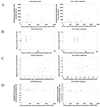Discordance between antibody and T cell responses in recipients of trivalent inactivated influenza vaccine
- PMID: 18339461
- PMCID: PMC2440689
- DOI: 10.1016/j.vaccine.2008.02.024
Discordance between antibody and T cell responses in recipients of trivalent inactivated influenza vaccine
Abstract
Thirty adults were tested for humoral and cellular immune responses following immunization with the trivalent inactivated influenza vaccine. Modest but significant inverse correlations between the baseline and the fold changes in the number of IFNgamma-producing cells and the levels of neutralizing antibodies were observed. Specific increases in proliferative responses in the CD8 CD45RA+ population were noted after vaccination. Minimal correlations between neutralizing antibody titers and the number of IFNgamma-producing cells in terms of prevaccination levels or fold increases were observed. These results show specific increases in a CD8 T cell subset and discordant T and B responses induced by the trivalent inactivated influenza vaccine.
Figures



References
-
- Harper SA, Fukuda K, Uyeki TM, Cox NJ, Bridges CB. Prevention and control of influenza: recommendations of the Advisory Committee on Immunization Practices (ACIP) MMWR Recomm Rep. 2004 May 28;53(RR6):1–40. - PubMed
-
- Hilleman MR. Realities and enigmas of human viral influenza: pathogenesis, epidemiology and control. Vaccine. 2002 Aug 19;20(25–26):3068–3087. - PubMed
-
- Yamada YK, Meager A, Yamada A, Ennis FA. Human interferon alpha and gamma production by lymphocytes during the generation of influenza virus-specific cytotoxic T lymphocytes. J Gen Virol. 1986 Nov;67(Pt 11):2325–2334. - PubMed
Publication types
MeSH terms
Substances
Grants and funding
LinkOut - more resources
Full Text Sources
Medical
Research Materials

